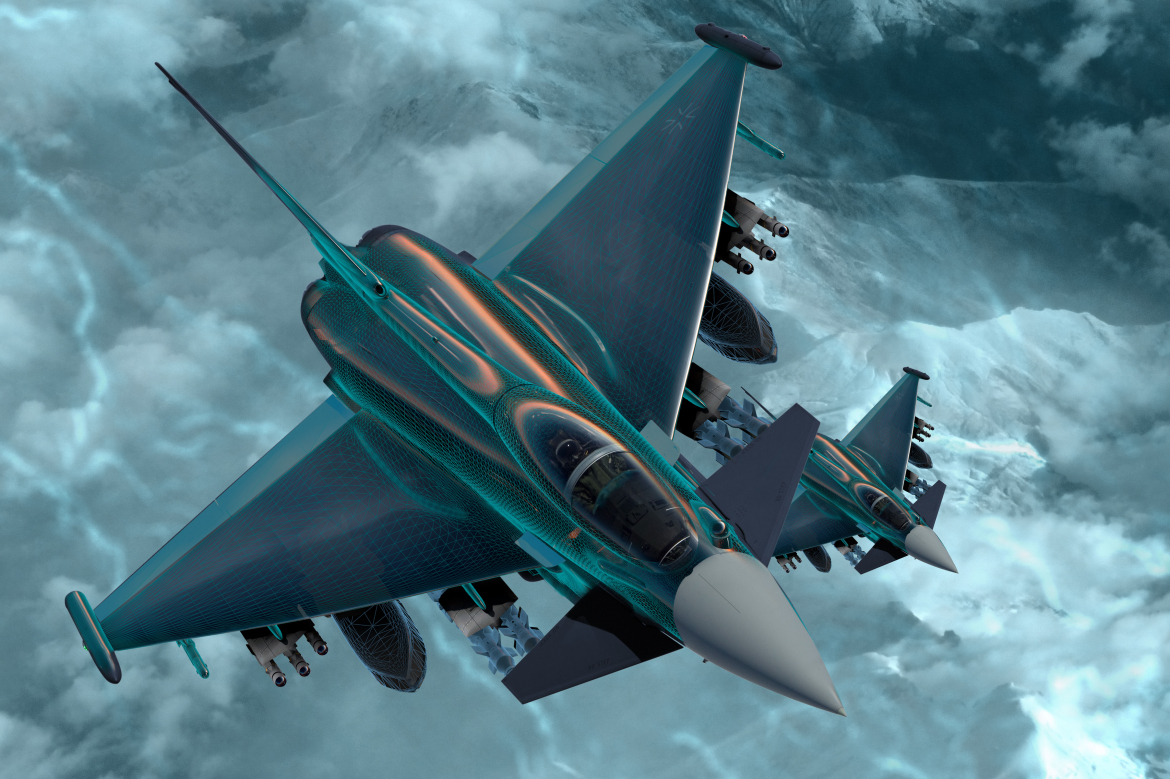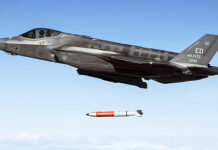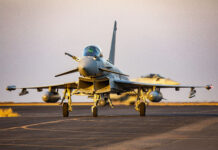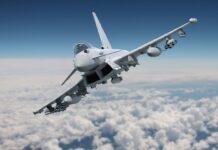Having now been in service for almost 20 years, the Eurofighter Typhoon is reaching full maturity as a combat air platform. While most of its users, in Europe at least, have now joined the ‘F-35 club’, the Typhoon will continue to operate as a potent complement to the F-35 for some years to come. Peter Felstead reports.
As the dominant indigenous fighter in Europe, the Eurofighter Typhoon began entering service with the four Eurofighter countries – Germany, Italy, Spain and the United Kingdom – from 2003.
The UK’s Royal Air Force (RAF) has 160 Typhoons but intends to retire its older Tranche 1 aircraft by 2025, leaving the force with 107 Typhoons: 67 Tranche 2 and 40 Tranche 3 aircraft. The RAF currently operates the Typhoon alongside the F-35 Lightning II. In terms of the future UK fighter force mix an RAF spokesperson stated on 20 January 2022, “The UK is committed to developing its Combat Air capability through continued capability growth in both the Lightning and Typhoon fleets as well as significant investment in the Future Combat Air System (FCAS, now the Anglo-Italian-Japanese Global Combat Air Programme (GCAP)).
Germany’s Luftwaffe, which has a total of 143 Eurofighters, is ultimately slated to replace that fleet with the Franco-German ‘other FCAS’ programme’s New Generation Fighter. However, in November 2020, under Project Quadriga, Berlin ordered 38 Tranche 4 Eurofighters to replace a similar number of Tranche 1 Eurofighters in the Luftwaffe inventory.
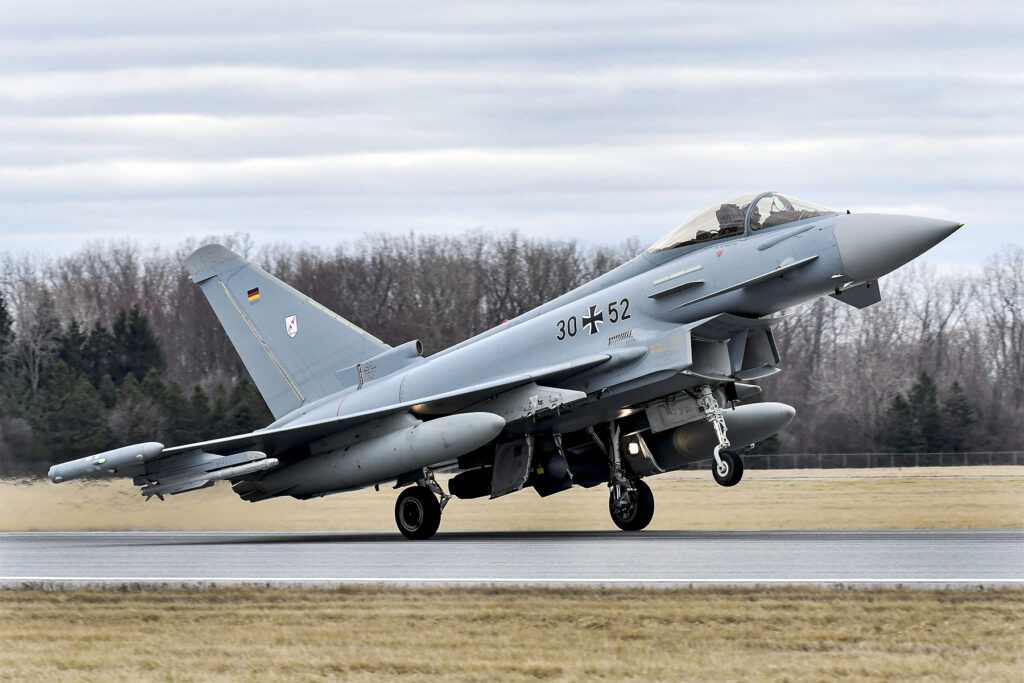
Credit: USAF
Beyond this buy, meanwhile, was the Luftwaffe requirement to replace its Panavia Tornado Interdiction/Strike (IDS) and Electronic Combat/Reconnaissance (ECR) fleets. In 2019 the German Ministry of Defence announced plans to acquire 30 Boeing F/A-18E/F Super Hornets and 15 Boeing EA-18G Growlers to address these respective requirements. However, following a change of government in Berlin at the end of 2021, in March 2022 Germany made the decision to buy 35 Lockheed Martin F-35s as strike platforms as well as 15 Typhoons for the ECR mission, with these aircraft now known as Eurofighter EK (Elektronischer Kampf) variants.
In Italy the country’s final Eurofighter was received into service in October 2020, completing a fleet of 96 aircraft. However, given that 26 of these are Tranche 1 aircraft and another 15 are ECR variants, it has been reported that Italy could yet make an additional Eurofighter purchase to cover the retirement of its 50 Panavia Tornado IDS strike aircraft and 13 Tornado ECR variants.
Spain, with 73 aircraft delivered, had up to recently operated the smallest fleet of the Eurofighter countries. However, in December 2021 Madrid approved the procurement of 20 new fighters to replace the Spanish Air Force EF-18 Hornets based on the Canary Islands under Project Halcón (Hawk). In June 2022 it was announced that Madrid had ordered 20 new Eurofighters to fulfil that requirement. Under that EUR 2.04 Bn (USD 2.15 Bn) deal Spain will acquire 16 single-seat and four twin-seat Tranche 4 Eurofighters, with deliveries to commence in 2026.
Beyond the Eurofighter Consortium nations the only other European operator of the type is Austria, where fighter plans were in a state of disarray in recent years. After deciding in 2017 that its 15 Tranche 1 Typhoons, in service since 2007, were too expensive to operate, Vienna then made a U-turn on that decision in 2020 after cracks were found in tail-section bolts of the Austrian Air Force’s dozen remaining Saab 105 jet trainers, which had been used as cheaper-to-operate air policing platforms. Austria thus continues as a Eurofighter operator, but is unlikely to invest in further enhancements to its fleet.
In the Middle East, meanwhile, the Eurofighter is operated by Oman, Kuwait, Qatar and Saudi Arabia, with fleets numbering 12, 28, 24 and 72 aircraft respectively.
Radars
In terms of enhancements to the Eurofighter’s combat capabilities, the most significant ongoing development is the adoption of active electronically scanned array (AESA) radar technology. Unlike the mechanically scanned radars typically installed in fourth-generation aircraft, AESA radars radiate multiple beams at multiple frequencies simultaneously, making them more difficult to detect and more resistant to jamming.
The first Eurofighter users to operate with this technology are the air forces of Kuwait and Qatar. Kuwait ordered 28 AESA-equipped Eurofighters in April 2016, while Qatar followed suit in December 2017 with an order for 24 aircraft. The AESA radar in these aircraft is what is now known as the European Common Radar System Mark 0 (ECRS Mk 0), which was developed by Leonardo.
European users of the Eurofighter, meanwhile, are pursuing two parallel paths with regard to AESA technology. Berlin ordered ECRS Mk 1 radars for its Project Quadriga Eurofighters under a contract awarded to Germany’s Hensoldt, supported by Spanish firm Indra, in April 2021, while Madrid’s Project Halcón order in June 2022 also covered Eurofighters equipped with the ECRS Mk 1.
The UK, meanwhile, is playing a longer game with regard to AESA technology and in July 2022 the UK Ministry of Defence (MoD) committed GBP 2.35 Bn (EUR 2.68 Bn) to a Typhoon upgrade that will see the adoption of the more advanced ECRS Mk 2 AESA radar developed by Leonardo UK. The MoD’s current planning assumption is that the ECRS Mk 2 will be fitted to the RAF’s 40 Tranche 3 Typhoons, although any further rollout of the technology is being kept under review.
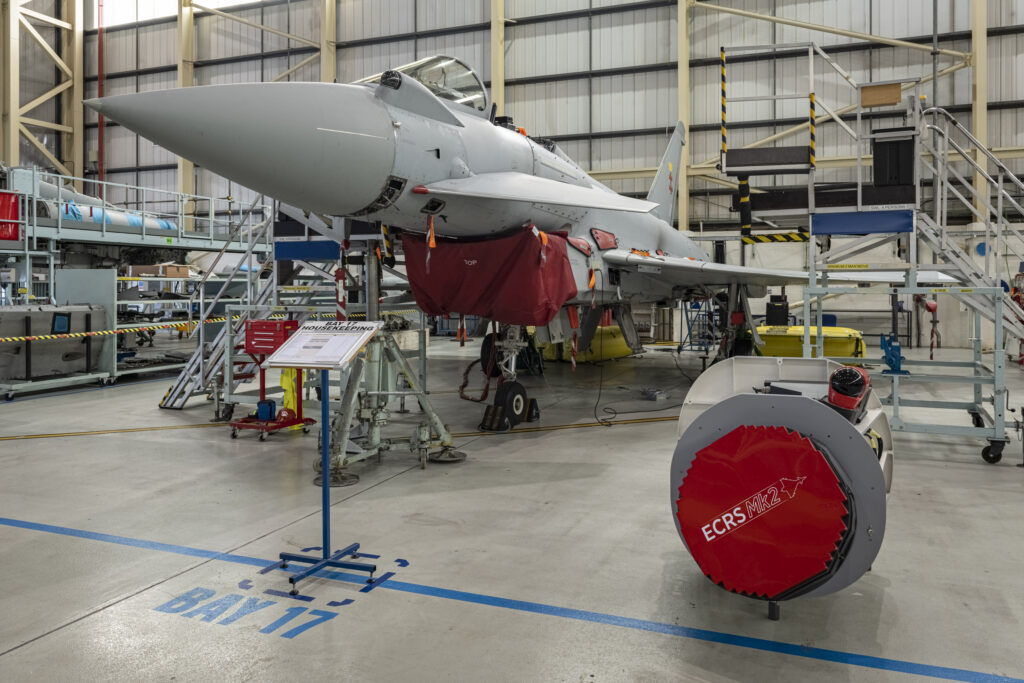
Credit: Leonardo
On 21 April 2023 it was announced that the first ECRS Mk 2 had been delivered by Leonardo UK to BAE Systems’ site in Warton, Lancashire, where it will undergo integration work and ground-based testing in preparation for first flights on a Typhoon in 2024.
The UK is paying a time penalty with the ECRS Mk 2 – it is essentially a completely new radar and its initial operational capability is forecast for 2030 – while its integration presents a considerably intrusive modification to the nose of the aircraft, but its capabilities offer a significant advantage.
While the ECRS Mk 1 is essentially an improvement to the ECRS Mk 0, both of those radars are essentially narrow-band arrays, so although they have many of the design advantages of a high-speed electronically scanned antenna, they are still designed primarily detect other airborne targets. The ECRS Mk 2, on the other hand, is a wide-band array that will not only detect its own emissions and find other targets in that way, but will also passively detect emissions through a far broader range of the frequency spectrum.
As Andrew Mallery-Blythe, Typhoon Operational Requirements Manager at BAE Systems, told ESD on 5 May 2023, the ECRS Mk 2 will be able to passively track airborne targets and other surface-based emitters as well without having to emit itself. “It’s a very, very high-gain sensor,” he explained, “and it can also emit throughout that wide band, that wide frequency range, and it can emit and potentially attack all of those emitters: surface emitters, airborne emitters, etc, so as an electronic attack and electronic warfare tool it’s hugely capable to do all of that while performing its primary role as an air-to-air sensor as well. And that’s why the UK have pursued it.”
With Leonardo UK leading the development of the ECRS Mk 2, it was announced in September 2021 that engineers from parent company Leonardo in Italy had joined the UK development team at its site in Edinburgh. Thus, while Italy has not formally committed to the ECRS Mk 2 for its Eurofighters, there is what may be described as ‘mood music’ implying that Italy may well adopt the ECRS Mk 2 for its Eurofighters.
Beyond Europe, the Royal Saudi Air Force (RSAF) has yet to decide on an AESA radar for its Eurofighter fleet. However, given that the RSAF typically aligns itself with UK capabilities, it is more likely than not that Saudi Arabia will ultimately also adopt the ECRS Mk 2.
Weapons
Beyond the Eurofighter’s internal 27 mm Mauser cannon, a wide array of missiles and bombs have been integrated onto the Eurofighter, although not all user nations operate every type of weapon. Short-range air-to-air missiles (AAMs) integrated onto the Eurofighter include the ASRAAM, IRIS-T and AIM-9 Sidewinder, while beyond-visual-range AAMs include the AIM-120 AMRAAM and Meteor. In terms of air-to-surface missiles UK, Italian and Saudi Eurofighters can deploy the Storm Shadow cruise missile, German and Spanish Eurofighters the KEPD 350 cruise missile, while UK, German and Saudi aircraft can also carry the Brimstone family of missiles. Precision-guided bombs integrated onto the Eurofighter include the Paveway II series of laser-guided bombs and Paveway IV dual-mode GPS/INS and laser-guided bomb, while Germany has also integrated the GPS/INS-guided GBU-54 Joint Direct Attack Munition (JDAM) onto the aircraft.
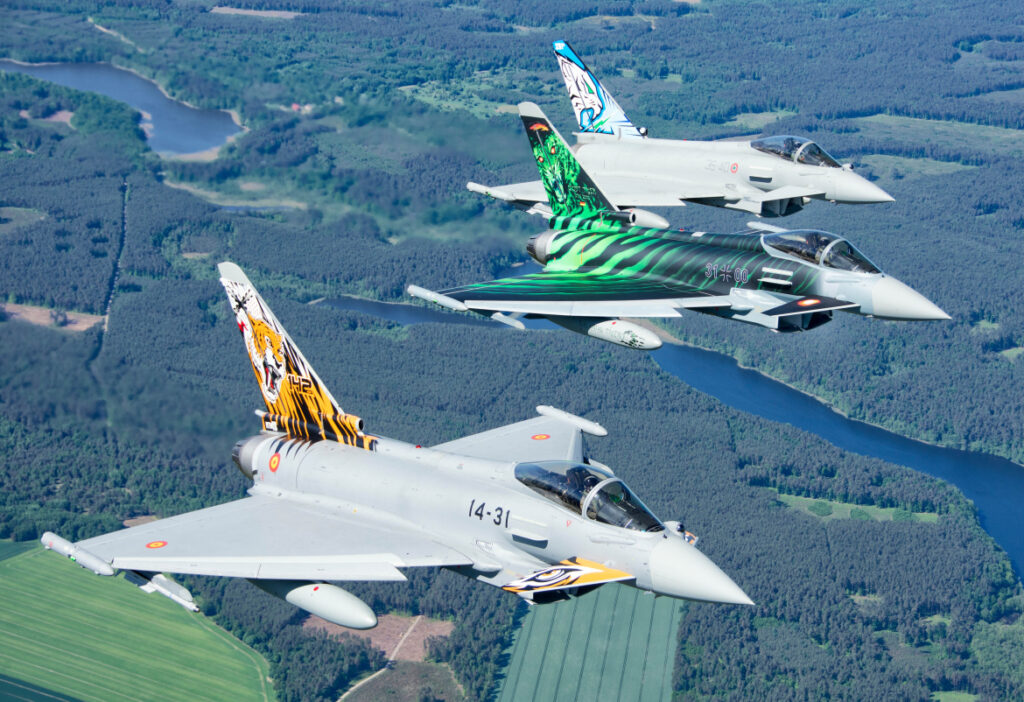
Credit: Eurofighter
Regarding future weapons integration, MBDA UK is going into production with the Brimstone 3 later in 2023, which, as Mike Mew, the company’s director of UK sales and business development, explained in a briefing on 10 May 2023, “has been modernised top to tail; the only thing that’s consistent with the original Brimstone is the external shape. [It has] new energetics, additional modes in the seeker, additional software modes for use from a wider range of launch platforms.” Given that Brimstone is already integrated on the Eurofighter, just a brief requalification process will be required for the aircraft to carry the Brimstone 3.
MBDA is also working on two largely classified concepts for a Future Cruise/Anti-Ship Weapon, which will be a successor to Storm Shadow. One is subsonic and designed to be very survivable through the use of stealth, while the other is supersonic and would rely more on high speed to defeat any air defences. Both concepts will move into the development phase from 2025, with a view to being put into service at the end of the decade. Whatever weapons proceed, they are likely to be integrated onto the UK’s Typhoons.
The Eurofighters in the RAF are currently at the Phase Three Enhancement A (P3EA) core avionics standard. While P4E has not yet finished its system definition phase, that package will bring integration of MBDA’s Select Precision Effects At Range (SPEAR) Capability 3 stand-off attack missile plus an electronic warfare (EW) variant of that weapon, SPEAR EW, in which the missile’s warhead is replaced by an EW payload to suppress enemy air defence radars.
Apart from weapons specifically, another key development in the UK is the implementation of enhancements to the RAF’s Rafael Litening V targeting pods, which first entered squadron service on RAF Typhoons in February 2022. The enhancements are being made under the UK’s National Delta Package (NDP) 1b Increment 2.2 in what BAE’s Mallery-Blythe bills as “the product of the year”. This standard is currently being tested and will be released later this year.
“Litening 5 is the most advanced targeted pod in the world,” said Mallery-Blythe. “It’s brought some amazing capability, both in the area of optics – much more powerful optics than have been seen before – and the ability to generate coordinates accurately. It’s vastly, vastly superior to the Litening III and that has brought real, tangible capability improvements on operations right now. It particularly helps you employ Brimstone.”
Mallery-Blythe explained that the Litening V enhancements under NDP 1.1 Increment 2.2 have added some improvements to the pod’s usability. “One capability is there’s a nudge feature, [which] just makes that tracking task easier for the operator,” he explained. “The autofocus capabilities have [also] been significantly improved, and I would just say that the overall slickness of the integration has been improved for the Litening V, and that’s going to make a real difference on operations.”
Beyond the UK, in August 2021 the Luftwaffe declared that its Eurofighters had become operational with the Meteor, which thus joined the IRIS-T and AIM-120 AMRAAM in the German Eurofighters’ air-to-air inventory.
Meanwhile, in December 2021 it was announced that MBDA’s Marte ER anti-ship missile had successfully completed its final test firing the previous month. Derived from the Marte MK2/S anti-ship missile, which is already in service with Italy and Qatar as a helicopter-launched weapon, the Marte ER is propelled by a turbojet in place of its predecessor’s rocket engine. While it is known that a feasibility study has been conducted by MBDA in relation to integrating the Marte ER on the Eurofighter, which was reportedly due to a request to Leonardo from a foreign customer that is likely to have been Qatar, it remains unclear how much further this development has progressed. However, one military aerospace analyst told ESD that he would not be surprised if the Marte ER was already in operation on Qatari Eurofighters.
Future Systems
As well as being fitted with the ECRS Mk 1 radar, the Tranche 4 Eurofighters being delivered to the Luftwaffe under Project Quadriga and to the Spanish Air Force under Project Halcón will also be equipped with the Praetorian Defensive Aids Sub-System (DASS). This system, provided by the EuroDASS consortium, will provide enhanced protection and situational awareness, as well as facilitating advanced electronic deception techniques.

Credit: Eurofighter
Regarding the Luftwaffe’s 15 Eurofighter EK variants, these are likely to receive a new EW pod being developed by Hensoldt in association with Israel’s Rafael Advanced Defense Systems. Integrating Hensoldt’s Kalaetron Attack technology into Rafael’s Sky Shield EW pod, this new system is expected to be integrated onto the Eurofighter EK variants around 2030.
Meanwhile, since 2019 the Eurofighter consortium has been working on a Long Term Evolution (LTE) study for the aircraft that aims to secure its operational relevance for some decades to come. This will cover every aspect of the platform, from its avionics to its powerplants. While any plans under the LTE study have yet to solidify, one key development is likely to be replacement of the Eurofighter’s three existing multi-function displays with a new touchscreen large area display (LAD). This would especially useful for presenting sensor fusion to the pilot in a manner found on fifth-generation combat aircraft like the F-35.
A Frequency Issue
One upcoming issue that the Eurofighter community will have to address is Multifunctional Information Distribution System (MIDS) frequency remapping in relation to the aircraft’s Link 16 datalink. MIDS frequency remapping is required to operate in a country that is changing the frequencies available to Link 16 to free up frequencies available to cell phones and other systems that use the radio frequency spectrum. Given the United States is a country that will be implementing these changes by 2025, air forces wanting to participate in the US ‘Red Flag’ air manoeuvres from that year, for example, will need to be compliant.
Additionally, changes to the IFF transponders of military aircraft will also be required in order to fly in controlled airspace around the world from 1 January 2025.
The UK is tackling these issues under its NDP 1c, which will be implemented in time for full international compliance in 2025, meaning that the RAF will not have to operate under any exemptions and will retain full operational flexibility with its Typhoon fleet.
Peter Felstead


